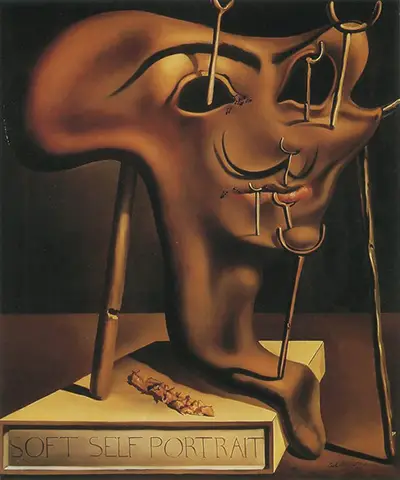Initially the image seems bizarre. A caricature of Dali's own face, complete with upturned moustache, appears on a plinth, like a trophy or bust.
The plinth bears the name of the name of the painting and has a single piece of fried bacon beside it.
Dali's eye's are missing, only the sockets are visible and have ants crawling around them.
Sections of the bronze, mask-like face are propped up with crutches of various sizes supporting the soft face as it appears to slide off the plinth. Dali manages to create a wonderful illusion of liquidity in this work, so that the face appears to be melting and sliding.
As with many of Dali's paintings, theories have been put forward to explain the various symbols that Dali used in his work, like the placement of ants and crutches.
In this piece, it seems that Dali knew his use of crutches was popular, so simply added more. However they are clearly providing "support".
The ants were often used as a symbol of decay, but in this image they are attracted to the food sources. Dali chose to offer his "outer self" or skin in this painting and imagined it like food, even bacon.
Dali described this as painting "the glove" instead of "the soul". Dali used the words " anti-psychological" to describe this particular self portrait.
Perhaps like some of the butterflies which featured in many of his paintings, Dali was undergoing metamorphosis in this piece, sliding off his old skin and moving away from psychoanalysis.
Possibly he was depicting himself opened out for the media to feed on.
Fascinating, surreal and perplexing. Dali's Soft Self-Portrait with Fried Bacon will remain as mysterious and engaging as Dali the artist was.

